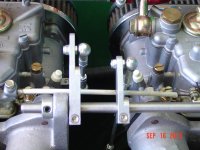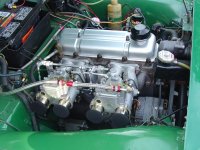M_Pied_Lourd
Darth Vader
Offline
Hi All,
Playing around with installing some Weber DCOE 42's on my 1960 TR3A.
I have a question on what I should do about the vacuum advance line from the distributor since there is no provision for this on the webers.
Should I cap it and run without? Thoughts on timing adjustments, dizzy re-curving etc if required?
Thanks for the help in advance.
Cheers
Tush
Playing around with installing some Weber DCOE 42's on my 1960 TR3A.
I have a question on what I should do about the vacuum advance line from the distributor since there is no provision for this on the webers.
Should I cap it and run without? Thoughts on timing adjustments, dizzy re-curving etc if required?
Thanks for the help in advance.
Cheers
Tush

 Hi Guest!
Hi Guest!

 smilie in place of the real @
smilie in place of the real @
 Pretty Please - add it to our Events forum(s) and add to the calendar! >>
Pretty Please - add it to our Events forum(s) and add to the calendar! >> 



